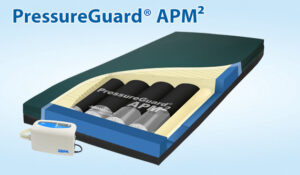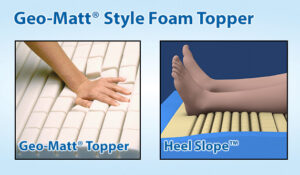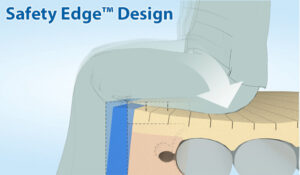PressureGuard® APM²
Alternating Pressure or Lateral Rotation at the Flip of a Switch! Now with Shear Transfer Zones™ and Digital Control Unit.
With its two distinct therapy modes, the PressureGuard® APM² gives you twice the treatment options. Twice the flexibility. Twice the value. And now enhanced cover and control unit features as well.
The APM2 has been an industry-leading air therapy solution for more than a decade, based in large part on its documented superiority vs. typical, roll-up treatment surfaces¹. An upgraded cover design and control unit now provide even greater immersion, envelopment, shear reduction, treatment flexibility, caregiver ergonomics and user comfort.
The cover’s enhanced features include the unique design of the anti-microbial bi-directional stretch cover made with Span’s superior LifeSpan® fabric.
 LifeSpan® is extremely durable and cleanable and delivers outstanding resistance to chemical breakdown caused by bleach and other harsh disinfectants with its polycarbonate-fortified coating
LifeSpan® is extremely durable and cleanable and delivers outstanding resistance to chemical breakdown caused by bleach and other harsh disinfectants with its polycarbonate-fortified coating
 Change instantly and easily from alternating pressure to basic lateral rotation with a single, recessed toggle switch. Requires no disconnecting or exchanging of air lines.
Change instantly and easily from alternating pressure to basic lateral rotation with a single, recessed toggle switch. Requires no disconnecting or exchanging of air lines.
 The dependable digital control unit is lightweight and quiet. The easy-to-use, white multi-functional control unit provides simple, indexed comfort adjustment and a selectable audible alarm. A timed (20 minute) “Auto Firm” mode facilitates caregiving activities such as transfers, ADLs and CPR and then returns to its previously selected mode..
The dependable digital control unit is lightweight and quiet. The easy-to-use, white multi-functional control unit provides simple, indexed comfort adjustment and a selectable audible alarm. A timed (20 minute) “Auto Firm” mode facilitates caregiving activities such as transfers, ADLs and CPR and then returns to its previously selected mode..
“Alternate Mode” changes loading in a 10-minute cycle of either alternating pressure or lateral rotation therapy as selected at the mattress. “Float” mode provides powered flotation therapy.
Indicator lights for “Low pressure” and “Power Failure” give users assurance-at-a-glance of proper function.
Weight limit: 350 lbs.
Mattress weight: 20 lbs.
Control Unit weight: 6.3 lbs., UL listed.
Warranty: 18-months (all components)
¹Carol Anderson, RN, PHN. Lateral Rotation Mattresses for Wound Healing
Ostomy/Wound Management April 2004:50(4): 50-62

Alternating Pressure and Lateral Rotation in one surface
Patented Safety Edge™ with ’cradling effect’ for user safety
Added protection of Shear Transfer Zones™
Quiet digital control unit with Auto Firm and Float modes

Creates shear-minimizing bands beneath heels, sacrum and scapula
Helps “glide” user to original position following gatching
Provides overall stability while offsetting friction
Polycarbonate-fortified, cleanable LifeSpan® cover

2″ deep topper reduces shear to underlying tissues
More than 800 individually-articulating cells
Redistributes pressure, reduces heat and skin moisture buildup
Heel Slope™ designed to further reduce heel pressure

Head-to-foot air cylinders for better pressure reduction
Better support in seat area when head of bed is raised
Individual foam cells accommodate bony prominences

Patented inner bolster ’cradling effect’ for user safety
Unmatched edge-of-bed stability
Helps ensure safer transfers
Minimizes risk of falls and entrapment
PressureGuard® APM2 Overview
How it works APM2 Shear Transfer Zones
Outstanding features of the unique PressureGuard






